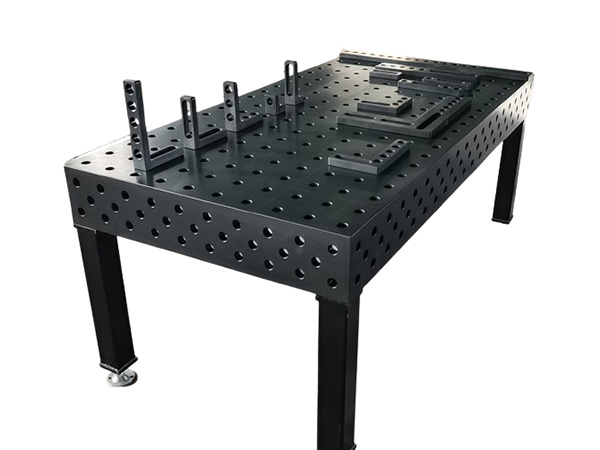- 网站导航 -
Address: Home > News > Technical documentation >
Material Selection and Durability Analysis for Welding Tables: Building a Sturdy and Efficient Workbench
Time:2024-10-06 01:47:05 Author:Fadetong Clicks:109Second-rate
Welding tables are indispensable tools in welding operations, influencing efficiency, safety, and product quality. Choosing the right materials for a welding table is crucial to achieve optimal performance and durability. This article delves into the materials used for welding tables and their durability to help you find the best solution for your needs.

1. Steel: The Top Choice for Welding Tables
Steel is the most commonly used material for welding tables due to its high strength, excellent heat resistance, and corrosion resistance. Here are the common types of steel used and their pros and cons:
Carbon Steel:
Pros: Moderately priced, high strength, suitable for most welding environments. Can withstand high temperatures but requires regular rust prevention treatments to extend its lifespan.
Cons: Susceptible to rust if not properly maintained.
Stainless Steel:
Pros: Outstanding corrosion resistance and aesthetic appeal. Ideal for environments requiring high hygiene standards and is low maintenance.
Cons: Higher cost compared to carbon steel.
Alloy Steel:
Pros: Enhanced wear resistance, heat resistance, and corrosion resistance due to added elements like chromium and molybdenum. Suitable for extreme conditions.
Cons: Typically more expensive.
Durability Analysis: Steel welding tables offer excellent durability, particularly those with rust-resistant and corrosion-treated surfaces. The high-strength steel construction supports heavy workpieces and remains stable under high-temperature welding conditions.
2. Aluminum: Lightweight with Good Corrosion Resistance
Aluminum welding tables are gaining popularity for their lightweight and good corrosion resistance properties. Aluminum tables have a lower density, making them suitable for environments requiring frequent table movement.
Pros: Lightweight, easy to handle, and resistant to rust, making them suitable for damp environments.
Cons: Lower strength compared to steel, can deform under high temperatures, and is less suitable for heavy-duty welding.
Durability Analysis: Aluminum tables are best suited for small-scale or lightweight welding tasks. Their lower impact resistance and shorter lifespan compared to steel tables make them less ideal for high-intensity welding operations.
3. Wood: A Common Choice for DIY Welding Tables
Wood is a common choice for DIY enthusiasts due to its low cost and ease of modification.
Pros: Affordable, easy to make and adjust.
Cons: Poor heat resistance, can catch fire or burn from welding sparks, not suitable for high-temperature welding tasks.
Durability Analysis: Wooden welding tables are not recommended for professional or industrial welding environments due to their short lifespan and low durability. Covering the surface with a steel plate or other heat-resistant material can improve durability and safety.
4. Composite Materials: Innovation and Practicality
Composite materials, which combine steel with other materials like fire-resistant or insulating layers, are becoming more prevalent in welding table applications.
Pros: Enhanced heat resistance, impact resistance, and lighter weight. Easy to move and adjust.
Cons: Higher cost and maintenance compared to single-material tables.
Durability Analysis: Composite material tables offer a balance of strength, heat resistance, and lightweight properties, making them suitable for complex industrial environments. Their longevity justifies the higher cost for those with substantial budgets.
Key Considerations for Welding Table Material Selection
Choosing the right material for a welding table is crucial for improving welding efficiency and ensuring safety. Consider the following factors:
Working Environment: For environments with high moisture or corrosive conditions, stainless steel or aluminum is preferable. For high-strength and heat-resistant needs, carbon or alloy steel is more suitable.
Usage Frequency and Intensity: High-intensity and frequent welding operations should use steel tables for durability and stability. For light or DIY tasks, aluminum or wood may suffice.
Budget: Steel tables offer a good balance of cost and performance. For higher protection needs or aesthetic requirements, investing in stainless steel or composite materials might be worthwhile.
Why Choose Our Welding Tables?
We provide high-quality welding tables with expert material selection advice. Our tables use the best steel and composite materials, ensuring strength, durability, and excellent corrosion resistance. Whether you need an industrial-grade welding table or a lightweight option for DIY projects, we can offer the ideal solution for your needs.
Choose Us for:
Customized Solutions: Tailored welding tables based on your requirements and budget.
Durable Design: High-quality materials and craftsmanship for long-lasting use.
After-Sales Support: Our professional team offers comprehensive support and maintenance services to ensure your welding table performs optimally.
Contact us today to customize your welding table! Get more information and personalized advice. Let us help you select the most suitable welding table to enhance your work efficiency and achieve a safer, more effective welding experience!
For expert advice and high-quality welding tables, reach out to us now! We look forward to working with you to drive innovation and success in your welding projects.











